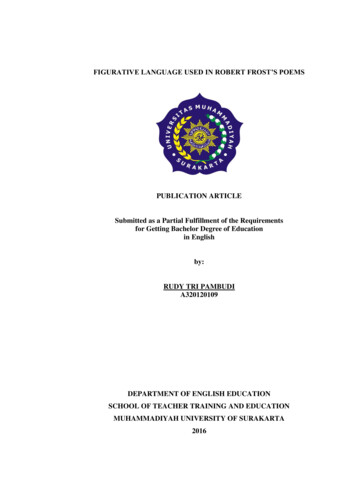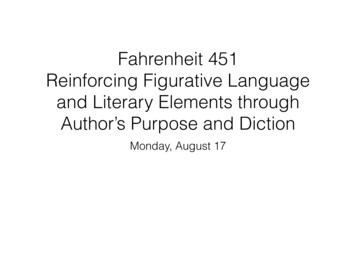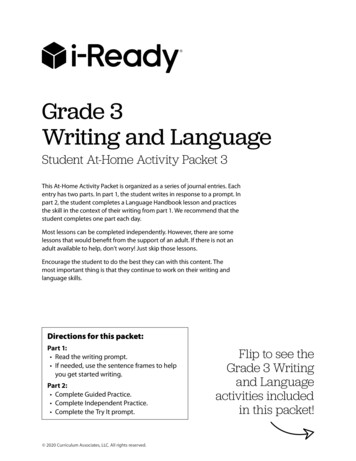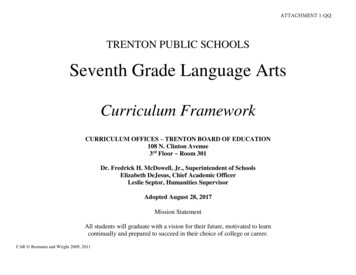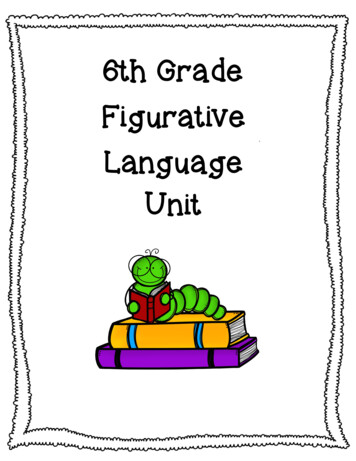
Transcription
6th GradeFigurativeLanguageUnit
Standards & BenchmarksICC L.6.5: Demonstrate understanding of figurative language, word relationships, and nuances in wordmeanings.a. Interpret figures of speech (e.g., personification) in context.b. Use the relationship between particular words (e.g., cause/effect, part/whole, item/category) to better understand each of the words.c. Distinguish among the connotations (associations) of words with similar deno-tations (definitions)Unit Objectives1. After completing a unit on figurative language, 6th gradestudents will be able to demonstrate knowledge of figurativelanguage with 80% accuracy.2. After completing a unit on figurative language, 6th gradestudents will be able to use figurative language to creativelyenhance their writing.
Our Standards-Based GradingGuidelines1. Students will be assessed on a scale of 1-4. A scoreof 1 would demonstrate that the student does notmeet the standard, and a score of 4 would demonstrate the student has achieved complete mastery ofthe standard.2. Participation points will be given for completion ofhomework; students will not be docked points for inaccuracy in their work.3. Additional enrichment activities will be available tohelp students develop mastery; no extra credit will beawarded for completion of these activities.4. Students are allowed to take up to one (1) reassessment per unit to reach the mastery level.5. The most recent data will be taken into account whendetermining final grade; early assessments can beoverlooked.
This unit includes .Four Lessons: Lesson Plan A (Similes)This lesson introduces students to figurative language and specifically similes. Thestudents create their own advertisement of a chosen product, and use similes toenhance their advertisement. Lesson Plan B (Metaphors)This lesson compares similes and metaphors in a hands-on activity. Students getthe chance to relate figurative language to their own lives as they decipher theuse of similes and metaphors in popular pop songs. Lesson Plan C (Personification)This lesson introduces students through the concept of personification by usingwhat they’ve seen in their world around them. Then, thestudents participate in a fun letter-writing assignment, writing from the point ofview of a non-human thing with human traits! Lesson Plan D (Idioms)This lesson finishes up the figurative language unit with a fun activity involving idioms. The students create their own poster to portray the two different meanings ofan idiom.Unit Summative AssessmentSupplemental Activity IdeasReassessment
Breakdown of Standards(Specific to this unit)1: Does not meet the standardStudents at this level are unable to demonstrate knowledge ofany of the four types of figurative language that are the focus of this unit. Below 50% on exam or writing assignment.2: Partially meets the standardStudents at this level are able to demonstrate someknowledge of the four types of figurative language. 50-70% onexam or writing assignment.3: Sufficiently meets the standardStudents at this level are able to demonstrate sufficientknowledge of the four types of figurative language. 70-90% onexam or writing assignment.4: Complete mastery of standardStudents at this level are able to demonstrate completeknowledge of the four types of figurative language: 90-100%on exam or writing assignment.
Lesson A: Similes6th Grade Language Arts45 minutes21 studentsStandard: ICC L.6.5: Demonstrate understanding of figurative language, wordrelationships, and nuances in word meanings.Benchmark: Interpret figures of speech (e.g., personification) in context.Objectives: After a lesson on similes, 6th grade students will be able to demonstrate accurate knowledge of similes through the creation of a produce advertisement using similes.Anticipatory Set: Share this video with students: https://www.youtube.com/watch?v oPIW0ZYkr5o. Ask students what did all of the movie quotes have incommon? What did you see in your mind when you heard them? How did thismake the movie more interesting?Instructional Input: Define similes: A comparison of two unlike objects using likeor as. Write two new examples on the board to demonstrate similes: e.g. “Easyas pie.”Have students turn and talk with their elbow partners and think of other examples of similes. Share some with the class.Modeling: Explain to students that advertisers often use similes to help themenhance their product. Give them examples such as Chevrolet’s “Like a Rock”slogan and State Farm’s “Like a good neighbor, State Farm is there.”
Guided Practice: Ask students to think of other examples of similes that theyhave seen in advertisements. Allow them to search the internet, or go throughold magazines. Have each student share their example.Independent Practice: Pair students up and explain that they will be creatingtheir own advertisement for any product they want (school-appropriate). Theymust include at least one simile in their advertisement. They could do a commercial, magazine advertisement, or billboard.Closure: In the last 10 minutes of class, have each partnership share their advertisement.Formative Assessment: As partners are sharing, the audience will need towrite down on a whiteboard the simile that was used in the advertisement. Thepartners sharing will check their peers’ work.Extensions: Students who need more of a challenge can create two commercials: one using a simile, and one without. This will help them and their peers tosee how similes help to enhance an advertisement.Modifications: If students don’t wish to share their product in front of the class,the teacher or another student can record their presentation and then sharethe video during the closure.
Lesson B: Metaphors6th Grade Language Arts45 minutes21 studentsStandard: ICC L.6.5: Demonstrate understanding of figurative language, wordrelationships, and nuances in word meanings.Benchmark: Interpret figures of speech (e.g., personification) in context.Objectives: After completing a lesson on metaphors, 6th grade students will beable to accurately identify similes and metaphors in music lyrics.Anticipatory Set: Review with students the definition of a simile. Tell studentsthat they will be working with another form of figurative language that compares two unlike objects, called a metaphor. Share this video with them: https://www.youtube.com/watch?v JcEV 3009gMInstructional Input: Continue working on the difference between metaphors andsimiles. A simile uses like or as, but a metaphor says one thing is another thing.Stress the importance that metaphors use two unlike objects. For example, in thevideo, the lyrics said “My heart’s a stereo,” but a heart can’t actually be a stereo.Modeling: Explain to students that they are going to continue searching for examples of similes/metaphors in songs. Lay down two hula hoops on the floor, withone labeled similes, and one labeled metaphors. Play the song “Firework,” byKaty Perry and write an example of both simile (like a plastic bag) and metaphor(you’re a firework) from the song and place in the corresponding hula hoop.Guided Practice: Have students help you find at least one more example of eachas you finish listening to the song.
Independent Practice: Play more songs such as, “Red” by Taylor Swift, “Life isa Highway,” by Rascal Flatts, “Hot and Cold,” by Katy Perry, “I’m Like a Bird,”by Nelly Furtado. Have students continue finding examples of each, writingtheir answers on strips of paper. This could be done in partnerships. At the end,have the students check each other’s work. Challenge to find the well-hiddenones so not everyone has the same answers.Closure: Have the students “turn and talk” and share with their partners thedefinitions of both similes and metaphors. Also, have them give examples ofeach.Formative Assessment: Have each partner group share what they discussedduring the turn and talk and informally assess their definitions and examplesfor accuracy.Extensions: Students who need more of a challenge can write their own song/rap that includes both similes and metaphors.Modifications: Have lyric sheets for the songs printed off for students who mayneed them as a reference.
Lesson C - Personification6th Grade Language Arts45 minutes21 studentsStandard: ICC L.6.5: Demonstrate understanding of figurative language, wordrelationships, and nuances in word meanings.Benchmark: Interpret figures of speech (e.g., personification) in context.Objectives: 1. After a lesson on personification, 6th grade students will be able toaccurately portray a personified object in a letter-writingassignment.Anticipatory Set: Review similes and metaphors and discuss how they help to enhance writing. Ask students what else makes writing fun to read. For example,in the book, “Charlotte’s Web,” what is unique about the spider? Or, what isunique about cartoon shows with animals?Instructional Input: Define personification: giving human traits to non-humanthings. Create a concept map including examples the students have seen withpersonification. This could include examples from t.v. shows, books, movies, etc.A probing question may be: What can Spongebob Squarepants do that realsponges cannot?ExamplePersonificationWhy is thispersonification?Modeling: Transition into an explanation of the assignment. Students will be writing a letter as a personified non-human object to a human of their choice. Theymust include an explanation of their non-human object’s human traits. Providestudents with the following model of a dog writing a letter to its owner. Have thestudents identify which human traits the dog has.
Guided Practice: Have students help complete the rest of the letter based onwhat they learned in the introduction. Encourage them to think of more humanlike traits that the dog might possess.Independent Practice: Explain to the students that they first need to pick a nonhuman thing and give them at least 3 human traits. Then, they’ll choose theirliving object that they’re writing the letter to. Use the attached worksheet forstudents to start their brainstorming.Give students the remainder of the class period to work.Closure: Towards the end of class, tell students if they haven’t completed theirassignment, they need to finish by the next class period.Formative Assessment: Gather students’ letters the following day. Allow timefor them to share to their classmates. Assess students on their ability to accurately personify a non-human object with at least 3 human-like traits.Extensions: Students who need more of a challenge can write the letter fromthe point-of-view of a living object to a non-human object. The living object wouldsuspect that the non-human object is personified. For example, a pet store owner wondering about what his animals do at night.Modifications: Students who need more structure could use the attached outlineof a letter format. This will help the task to seem less overwhelming for students who struggle with writing.
Dear Owner,It may some odd that you are receiving a letter from me, yourdearest dog, but I wanted to let you know that I do understandwhen you are speaking to me and I always have fun playingwith you. I also have some important and exciting news toshare with you.When you’re not around, I talk to my cat friends, but they’redefinitely not as cool as you are. So, I left the farm one dayand as I was walking up the road, I discovered that I had superhero powers!I could walk on just two legs, and I could begin to talk to otherhumans around me.I’m looking forward to hearing from you.Love, Chloe
Personification LetterFirst, choose your non-human object:Then, choose their 3 human traits:Finally, choose the living objectwho will be the audience of yourletterGet a piece of lined paper and start writing!
Dear ,(Introduction)(Body)(Closing Sentence)Sincerely,
Lesson D: Idioms6th Grade Language Arts45 minutes21 studentsStandard: ICC L.6.5: Demonstrate understanding of figurative language, wordrelationships, and nuances in word meanings.Benchmark: Distinguish among the connotations (associations) of words with similardenotations (definitions).Objective: After a lesson on idioms, 6th grade students will be able to accuratelyportray the two different meanings of an idiom.Anticipatory Set: Review with the students the three different types of figurative language that have been previously discussed: similes, metaphors, and personification. Have students give an example of each. Ask students if they’ve ever read Amelia Bedelia; read a page from the book where she misinterpretsher directions. Have the students describe what she was really supposed to doas opposed to what she actually did.Instructional Input: Define what an idiom is: saying or expression that is used ineveryday language, but it has a different meaning than what is actually beingsaid. Have the students describe how the book Amelia Bedelia represents an idiom. Discuss why we use idioms in our writing.Modeling: Tell the students that they are going to be doing a fun activity to represent an idiom. Model the assignment by using the examples from the AmeliaBedelia worksheet. The students will be drawing a picture of what the idiommeans literally, and what it means as an expression. For example, when AmeliaBedelia is told to “dress the chicken,” she puts clothes on the chicken instead ofputting stuffing inside. Model how to do the literal picture by drawing a sketchof Amelia Bedelia dressing the chicken in clothes.
Guided Practice: Have the students work together to describe what the expression actually means. Then, choose one or two volunteers to finish the other halfof the poster.Independent Practice: Tell the students they are now going to be doing the samething on their own. They can research their own expression to use, or they canchoose from the provided list. Make sure the students understand they alsoneed to write an explanation of their pictures. Have the students take turnssigning up for an idiom to prevent any repeats.Closure: Tell the students they have the rest of class to complete their idiom assignment. If they don’t finish, it should be finished by the next class period. Theywill be sharing their poster to their peers the next day.Formative Assessment: As the students share, assess them on their verbal explanation of their literal meaning and the expressive meaning. Collect theirwork and assess it for accuracy and creativity. Use this information to seewhere students are at, and who may need more supplemental work before thefinal exam.Extensions: For students needing a challenge, they can complete the poster, andthen write a poem using their chosen idiom and as many others as they canthink of.Modifications: If students are hesitant to share, set up a separate meeting timewhen they can share exclusively with the teacher.For students who might struggle with the concept, they might benefit from having one side of the poster already filled out, so they only have to do one of themeanings of the idiom.
IdiomsMy expression:Literal Meaning (Dictionary Definition)
IdiomsMy expression:Expressive Meaning
Possible IdiomsA penny for your thoughts Barking up the wrong tree Bite off more than you can chew At the drop of a hatCross that bridge when you come to it Costs an arm and a legEvery cloud has a silver liningFeeling under the weather Hit the nail on the head Hit the sackLet the cat out of the bag Piece of cake Steal someone’s thunder Take with a grain of salt
Summative Assessment: Option 1For this option, students will need to write a short story andinclude all four types of figurative language in their story.The story must be at least 1 page long and can be handwritten or typed. The students will also need to include an explanation of how they used the figurative language in their writing and why it helps to make their writing better. Use the following rubric to assess their short story.1Similes2Student does not Student uses simiuse similes in writ- le, but inaccurateing.ly.34Student uses simiStudent uses sile accurately, but milie both creatividoes not flow with ty and accuratelythe story.to enhance story.Student uses metaphor, but inaccurately.Student uses metaphor accurately,but does not flowwith the story.Student uses metaphor both creativity and accurately to enhancestory.PersonificationStudent does notuse personification in writing.Student uses personification, butinaccurately.Student uses personification accurately, but doesnot flow with thestory.Student uses personification bothcreativity and accurately to enhance story.IdiomsStudent does notuse idioms in writing.Student uses idioms, but inaccurately.Student uses idioms accurately,but does not flowwith the story.Student uses idioms both creativity and accuratelyto enhance story.MetaphorsStudent does notuse metaphors inwriting.
Summative Assessment Option 2Identify if the phrase is a simile (S), metaphor (M), personification (P),or Idiom (I).1. It’s raining cats and dogs.2. As pretty as a flower3. Loving him was red4. The wind howled5. Yellow like the sunshine6. The thunder roared7. Cute as a button8. My school’s a zoo9. You can’t teach an old dog new tricks10. Life is a roller coaster rideWrite a sentence using an example of each.Personification:Idiom:Simile:Metaphor:
Summative Assessment Option 2 ANSWER KEYIdentify if the phrase is a simile (S), metaphor (M), personification (P),or Idiom (I).1. I It’s raining cats and dogs.2. S As pretty as a flower3. M Loving him was red4. P The wind howled5. S Yellow like the sunshine6. P The thunder roared7. S Cute as a button8. M My school’s a zoo9. I You can’t teach an old dog new tricks10.M Life is a roller coaster rideWrite a sentence using an example of each.Personification: Answers will vary.Idiom: Answers will vary.Simile: Answers will vary.Metaphor: Answers will vary.
Reassessment Procedures1. Supplemental activities must be completed prior toreassessment; the purpose of these activities is toensure the student made a genuine attempt to develop the skills he/she was lacking prior to the original assessment.2. The student must set up a reassessment time withthe corresponding teacher a week in advance.3. Each student can only reassess in one subject at atime to prevent possible scheduling issues thatcould arise.4. A student cannot reassess after one month haspassed from the original assessment date.5. If the student does not reach mastery level afterreassessment, RTI (response-to-intervention) activities will be made available to continue working onthese skills.
Supplemental Activities Choose your favorite song (must be school appropriate) and find examples of the four types of figurativelanguage in it. Use the figurative language log.Watch a Disney movie and keep track of the similes,metaphors, personification, and idioms used in themovie. Use the figurative language log.Find examples of figurative language in your favorite picture book. Use the figurative language log.Keep a log of figurative language expressions youhear in every day conversations. Use the attachedfigurative language log.Write a poem about a day in the life of a celebrity.Use all four types of figurative language.
Figurative Language LogSimileMetaphorPersonificationIdiom
Re-Assessment: Option 1For this option, students will need to write a short story andinclude all four types of figurative language in their story.The story must be at least 1 page long and can be handwritten or typed. The students will also need to include an explanation of how they used the figurative language in their writing and why it helps to make their writing better. Use the following rubric to assess their short story.1Similes2Student does not Student uses simiuse similes in writ- le, but inaccurateing.ly.34Student uses simiStudent uses sile accurately, but milie both creatividoes not flow with ty and accuratelythe story.to enhance story.Student uses metaphor, but inaccurately.Student uses metaphor accurately,but does not flowwith the story.Student uses metaphor both creativity and accurately to enhancestory.PersonificationStudent does notuse personification in writing.Student uses personification, butinaccurately.Student uses personification accurately, but doesnot flow with thestory.Student uses personification bothcreativity and accurately to enhance story.IdiomsStudent does notuse idioms in writing.Student uses idioms, but inaccurately.Student uses idioms accurately,but does not flowwith the story.Student uses idioms both creativity and accuratelyto enhance story.MetaphorsStudent does notuse metaphors inwriting.
Re-Assessment Option 2Identify if the phrase is a simile (S), metaphor (M), personification (P),or Idiom (I).1. Hair of silk2. Easy as pie3. The grass danced in the wind4. Slept like a log5. Give you the cold shoulder6. It was a piece of cake7. My mouth is a volcano8. Busy as a bee9. The house was drowning after the rain10. The room is an oven.Write a sentence using an example of each.Personification:Idiom:Simile:Metaphor:
Re-Assessment Option 2 ANSWER KEYIdentify if the phrase is a simile (S), metaphor (M), personification (P),or Idiom (I).1. M Hair of silk2. S Easy as pie3. P The grass danced in the wind4. S Slept like a log5. I Give you the cold shoulder6. I It was a piece of cake7. M My mouth is a volcano8. S Busy as a bee9. P The house was drowning after the rain10.M The room is an oven.Write a sentence using an example of each.Personification: Answers will vary.Idiom: Answers will vary.Simile: Answers will vary.Metaphor: Answers will vary.
6th Grade Language Arts 45 minutes 21 students Standard: ICC L.6.5: Demonstrate understanding of figurative language, word relationships, and nuances in word meanings. Benchmark: Interpret figures of speech (e.g., personification) in context. Objectives: After a lesson on similes, 6
